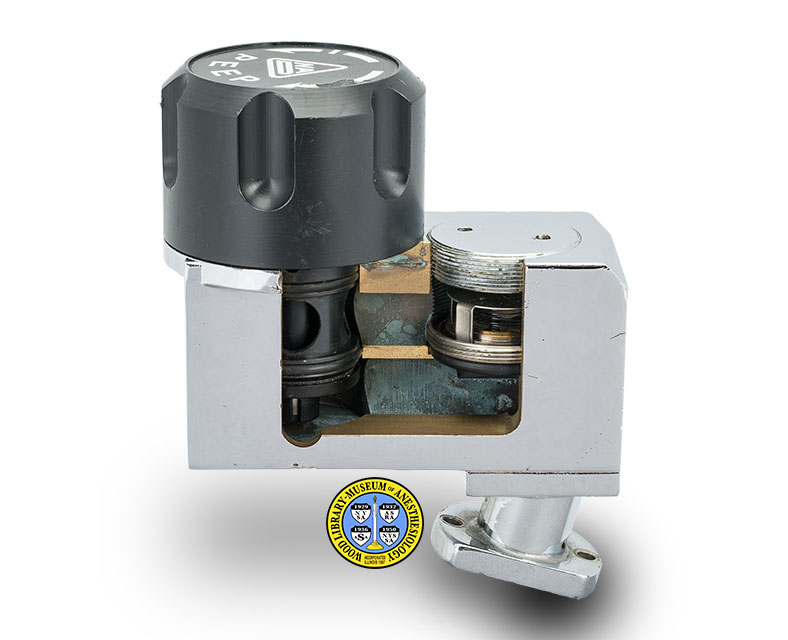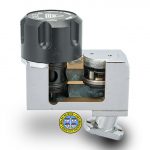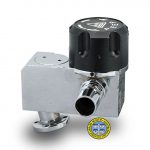N.A.D. PEEP Valve
Positive end-expiratory pressure (PEEP) is a technique of respiratory therapy that maintains a positive airway pressure during expiration. This prevents the patient's lungs from fully deflating when they exhale, improving the exchange of oxygen, carbon dioxide and anesthetic gases.
A subsidiary of the German equipment maker, Dräger, North American Dräger (NAD) was co-founded in Telford, Pennsylvania by former Dräger engineer Mr. Peter Schreiber in 1968. NAD introduced its first clinical machine, the Narkomed, in 1972. From the Narkomed model 2A, introduced in 1982, through the Narkomed model GS, introduced in 1997, NAD offered a PEEP valve as an optional feature that could be added either to the ventilator or to the carbon dioxide absorber on its machines.
The example shown here was dissected by Mr. James Yoder, who worked as a machinist at NAD for over 20 years. He formed a museum of NAD equipment at the company's headquarters, where he used this and other cutaways to teach students in technical training classes. Mr. Yoder later donated his collection to the WLM.
Catalog Record: N.A.D. PEEP Valve NAD PEEP Valve
Access Key: aqsw
Accession No.: 2014-02-15-1 AC
Title: [PEEP valve] / North American Dräger.
Corporate Author: North American Dräger.
Title variation: Alt Title
Title: Positive end-expiratory pressure valve.
Publisher: Telford, Pennsylvania : North American Dräger , [between ca. 1980 and 2014].
Physical Description: 1 respiratory valve : metals, plastics ; 10 x 10.5 x 12.5 cm.
Subject: Anesthesia, Inhalation – instrumentation.
Subject: Pressure Relief Valves.
Subject: Ventilation, Mechanical.
Note Type: General
Notes: The first year in the range of possible dates of manufacture is based on the 1982 date of introduction of the Narkomed model 2A. This was the first Narkomed model known to have had the PEEP valve as an optional feature. The actual first year of manufacture may have been earlier. The second year in the date range is the year that the last year that the object was donated to the WLM; the actual last year of manufacture is likely to have been earlier.
Described with the knob facing forward and the dissected side on the right.
Note Type: Citation
Notes: Carroll G. PEEP valve. YouTube.com. https://www.youtube.com/watch?v=CDEYWok94uQ. (Accessed May 29, 2018).
Note Type: Citation
Notes: Elliot WR, Harris AE, Philip JH. Positive-end expiratory pressure: applications for tidal volume changes in anesthesia machine ventilation. J Clinical Monitoring. April, 1989;5(2):100-104.
Note Type: Citation
Notes: Fairley HB. Continuous positive-pressure breathing (CPPB) in adult respiratory distress syndrome. Survey of Anesthesiology. June, 1970;14(3):236-237.
Note Type: Citation
Notes: Kirby RR, Smith RA, Desautels DA, eds. Mechanical Ventilation. New York: Churchill Livingstone, 1985:84-93.
Note Type: Citation
Notes: Mushin WM, Rendell-Baker L, Thompson P, Mapleson WW. Automatic Ventilation of the Lungs, 3rd ed. London: Blackwell Scientific Publications, 1980:206.
Note Type: Citation
Notes: National Library of Medicine (NLM) website. https://meshb.nlm.nih.gov/record/ui?ui=D011175. (Accessed June 1, 2018.)
Note Type: Citation
Notes: Navalesi P, Maggiore SM. Positive end-expiratory pressure. In: Tobin MJ, ed. Principles and Practice of Mechanical Ventilation, 2nd ed. New York: McGraw Hill, 2006:273-325.
Note Type: Citation
Notes: North American Dräger Company File. Archives. Located at Wood Library-Museum of Anesthesiology, Schaumburg, Illinois.
Note Type: Citation
Notes: Orkin L. Alveolar-arterial O2 differences during artificial respiration in man. Survey of Anesthesiology. October, 1960;4(5):470-471.
Note Type: Physical Description
Notes: One positive end-expiratory pressure valve; Consists of a large black plastic valve seated in a rectangular metal (chrome?) housing; The control knob of the valve occupies the lower half of the front side of the housing; The knob is marked, from top to bottom: “[Arrows facing left and right] [“NAD” logo] PEEP”; A stepped connecting tube, approximately 5 centimeters in length, extends from left side of the housing behind the knob; Where the tube attaches to the housing, it is approximately 2.5 centimeters in diameter; At the free end, the tube is approximately 1 centimeter in diameter; The opposite end of the tube aligns with an opening in the stem of the valve inside the housing;
The right side of the housing has been opened to reveal the inner workings; These consist of a metal valve in the upper half and the stem of the black plastic valve in the lower half; The top, back and right sides of the housing are unmarked; The bottom of the housing bears an adhesive label that reads: “NORTH AMERICAN DRAGER [new line] 1488 QUARRY ROAD [new line] TELFORD, PA. 18969 USA [new line] MODEL PEEP-A [new line] SER. NO. 5050”; At the upper end of the back of housing, a connector extends outward approximately 3.5 centimeters; This connector is seated at a downward angle.
Note Type: Reproduction
Notes: Photographed by Mr. Steve Donisch, January 16, 2018.
Note Type: Acquisition
Notes: Gift of Mr. James Yoder.
Note Type: Historical
Notes: Anesthesiologists are responsible for maintaining the patient’s vital functions, including respiration, during anesthesia. “Positive-Pressure Respiration” is defined by the National Library of Medicine (NLM) as “a method of mechanical ventilation in which pressure is maintained to increase the volume of gas remaining in the lungs at the end of expiration, thus reducing the shunting of blood through the lungs and improving gas exchange.” NLM notes that this must be distinguished from the medical condition “Positive-Pressure Respiration, Intrinsic”, which is defined as “a type of respiratory insufficiency.”
One method used in positive-pressure respiration is Positive End-Expiratory Pressure (PEEP). Navalesi and Maggiore (page 273) define PEEP as “a technique of respiratory therapy, in either spontaneously breathing or mechanically ventilated patients, in which airway pressure is maintained above atmospheric pressure throughout the respiratory cycle by pressurization of the ventilatory circuit.” Mushin et al. (p. 206) credit Frumin et al. with publishing “the first description of the benefit of PEEP” in 1959. They credit Ashbaugh et al. with the clinical introduction of PEEP ventilation, ten years later. Some PEEP valves direct air and gases unidirectionally (one way, either in or out), while others are bidirectional (directing flow both in and out.) Descriptions of the NAD PEEP valve suggest that the cataloged object is an expiratory valve.
A subsidiary of the German anesthesia machine maker, Dräger, North American Dräger (NAD) was founded in Telford, Pennsylvania by former Dräger engineer Mr. Peter Schreiber and his partners in 1968. NAD introduced its first clinical machine, the Narkomed Anesthesia System, in 1972. From the Narkomed model 2A, introduced in 1982, through the Narkomed model GS, introduced in 1997, NAD offered a PEEP valve as an optional feature that could be added either to the electronic ventilator or to the carbon dioxide absorber on its machines.
The cataloged object was dissected by Mr. James Yoder, who worked as a machinist at NAD for over 20 years. In 1993 he created a museum of NAD equipment at the company’s headquarters in Telford, where he used this and other cutaways to teach students in technical training classes. When that museum was closed, Mr. Yoder donated his collection to the WLM.
Note Type: Provenance
Notes: Formerly displayed in Mr. Yoder’s personal museum of North American Dräger equipment, in Telford, Pennsylvania.
Note Type: Publication
Notes: Frumin MJ, Bergman NA, Holaday D, et al. Alveolar-arterial O2 differences during artificial respiration in man. J Applied Phyiology. September, 1959;14:694-700.
Note Type: Publication
Notes: Ashbaugh DG, Bigelow DB, Harris TM, Petty TL. Continuous positive-pressure breathing (CPPB) in adult respiratory distress syndrome. J Thorac Cardiovasc Surg. January, 1969;57:31-41.
Note Type: Exhibition
Notes: Selected for the WLM website.



